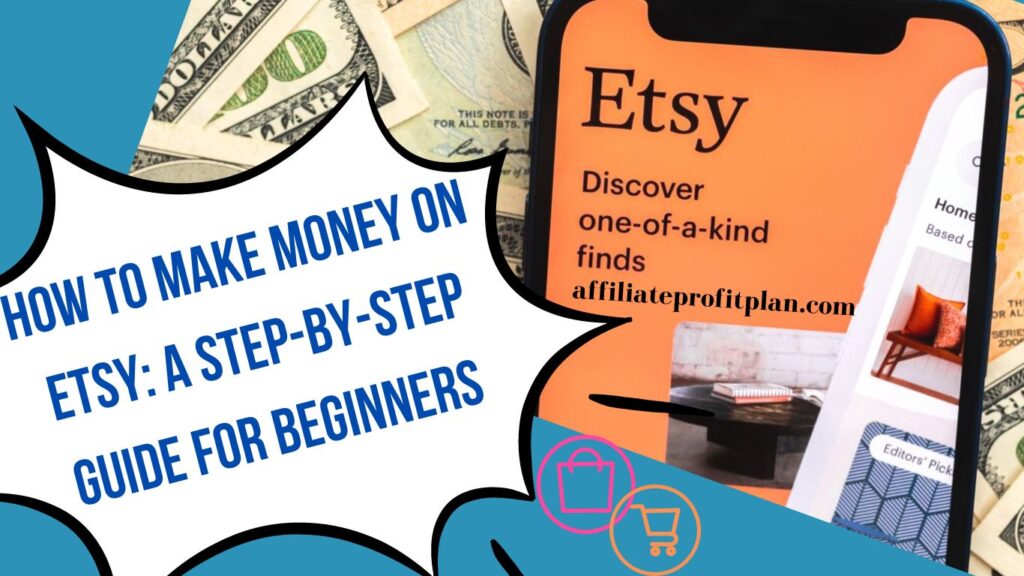Welcome to my article How to Make Money on Etsy: A Step-by-Step Guide for Beginners. Have you ever looked at your handmade crafts, vintage finds, or quirky designs and thought, “People would totally buy this!” Well, you’re not wrong. In fact, millions of people are turning their creativity into cash on Etsy, the online marketplace that celebrates everything from hand-knit scarves to custom wall art. If you’ve been thinking about setting up shop, you’re in the right place. (And no, you don’t need to be a DIY guru or have a degree in business to succeed.)
Whether you’re a seasoned crafter or just someone with an idea and a glue gun, Etsy offers a fantastic opportunity to turn your hobbies into income. But here’s the thing: just because Etsy is an easy platform to start doesn’t mean it’s an automatic cash cow. You need strategy, a bit of know-how, and some patience to stand out in a sea of sellers. Don’t worry—we’re here to walk you through every step, from setting up your shop to marketing your products like a pro. So, grab your favorite crafting supplies, fire up that creative brain of yours, and let’s dive into how you can make real money on Etsy.
Access My Proven Blueprint for $50-$100 Daily Income – Watch This FREE Video Now >>>

Understanding Etsy: Is It the Right Platform for You?
Before you jump headfirst into the Etsy world with visions of glitter-filled success, it’s worth asking: is Etsy the right place for your products? Etsy is like the friendly neighborhood marketplace of the internet, but it’s not for everyone. Think of it as an online farmer’s market, but instead of organic veggies and handmade soap, you’ve got everything from bespoke jewelry to vintage teacups and digital art prints. If your products fall under the categories of handmade, vintage (at least 20 years old), or craft supplies, then congrats—you’re in the right place!
Who Should Sell on Etsy?
If you’re an artist, maker, or treasure hunter, Etsy could be your new best friend. It’s perfect for creative souls who want to share their one-of-a-kind products with a global audience. Whether you’re into designing handmade jewelry, crocheting cat sweaters (yes, people buy those), or curating retro home décor, Etsy gives you access to customers looking for something special and unique. However, if you’re selling mass-produced items or products that lack that personal touch, Etsy might not be your vibe. Stick to what makes Etsy special: creativity, craftsmanship, and a sprinkle of uniqueness.
Pros and Cons of Selling on Etsy
Let’s start with the good stuff: Etsy makes it ridiculously easy to get started. You don’t need to be a tech wizard to set up shop, and Etsy already has a built-in audience of millions of people actively searching for products like yours. It’s also a trusted platform, which means buyers feel comfortable shopping there, and you won’t have to do all the heavy lifting when it comes to marketing.
Now, the not-so-glamorous part: Etsy isn’t a free ride. There are listing fees, transaction fees, and payment processing fees that can nibble away at your profits. Plus, competition is fierce—if you think you’re the only one selling hand-painted flower pots, think again. But don’t let that discourage you! With the right strategy (which we’ll get into later), you can still carve out your own niche and thrive.
So, is Etsy right for you? If you’ve got creativity, a unique product, and a little bit of entrepreneurial spirit, then Etsy could be the perfect platform to showcase your talents and make some money. Just remember: success doesn’t happen overnight, but with patience and a solid plan, you’ll be well on your way to Etsy stardom.
Setting Up Your Etsy Shop: The Basics
Alright, so you’ve decided Etsy is your place. Time to set up shop! But before you start dreaming about all the cash you’ll be swimming in like Scrooge McDuck, let’s talk about how to get your Etsy store up and running smoothly.
Step 1: Creating an Etsy Account
First things first, you’ll need to create an Etsy account (obviously). Head over to Etsy’s website, click the “Sell on Etsy” button, and follow the prompts. It’s kind of like setting up a social media profile but with a lot more potential for profit. Fill in your details, choose your language, country, and currency, and voilà—you’re ready to get started.
Step 2: Choosing a Catchy Shop Name
Now comes the fun part—naming your shop. This is where your inner branding guru gets to shine! You’ll want something catchy but not too quirky. Your shop name should be easy to spell and remember, but also give customers a clue about what you’re selling. Are you crafting eco-friendly candles? Maybe “EarthyGlow Creations.” Selling custom pet portraits? How about “Pawtrait Perfection”? Get creative.
Step 3: Adding Payment and Shipping Details
Etsy allows you to accept multiple forms of payment, from credit cards to PayPal, so make it as easy as possible for customers to give you their money. And when it comes to shipping, make sure you know what your costs will be—nothing ruins a sale faster than a customer getting hit with unexpected shipping fees at checkout. Pro tip: offer free shipping when you can, and just bake the cost into your pricing. Shoppers love that “free shipping” magic.
Step 4: Personalizing Your Shop
Okay, now we’re getting to the fun part—making your shop look snazzy! You’ll want to upload a professional-looking shop banner and profile photo to give your shop a polished, trustworthy vibe. This isn’t the time for blurry selfies or pictures of your cat (unless you’re selling cat-themed products, in which case… carry on). Fill out your “About” section with a short, engaging blurb about who you are and why your products are awesome. People love a good story, so don’t be shy—share what inspired you to start your shop and give customers a peek behind the curtain.
Step 5: Listing Your First Product
Now that your shop is all set up, it’s time to list your first product! Write a killer title (with SEO-friendly keywords—more on that later), a detailed description, and upload some crisp, high-quality photos of your item. Etsy shoppers are visual creatures, so the better your photos, the more likely people are to click “add to cart.” Don’t skimp on this step—it’s the difference between your product sitting in a dusty digital corner and flying off the (virtual) shelves.
That’s it! You’re officially an Etsy seller. Now comes the exciting part—building your brand and watching those orders roll in. Keep things simple at first, and don’t worry if everything isn’t perfect right away. You can always tweak and adjust your shop as you learn the ropes.
Product Listings That Sell: Optimizing for Etsy Search
Now comes the million-dollar question: how do you get people to find your stuff on Etsy? This is where Etsy SEO (Search Engine Optimization) comes into play. Think of it like putting your products on a virtual billboard that says, “Hey, over here! You need this handmade dog sweater!” Optimizing your product listings can mean the difference between sitting pretty on page one of Etsy search results or being lost in a sea of soapmakers.
Access My Proven Blueprint for $50-$100 Daily Income – Watch This FREE Video Now >>>
Writing Compelling Titles
Let’s kick things off with your product title. Be clear, be descriptive, and, most importantly, be keyword-smart. Your title should tell Etsy (and your customers) exactly what you’re selling. Think of the keywords that your target audience would type in—”handmade leather journal,” “boho wall hanging,” or “custom pet portrait”—and make sure to use them. But don’t stuff your title like a Thanksgiving turkey; keep it natural and easy to read.
Crafting Descriptions That Convert
Now for the description. This is where you get to show off a little! Your product description should do more than just describe what the item is—it should paint a picture of why someone absolutely needs this in their life. You’ve got to tap into their imagination. If you’re selling a cozy hand-knit blanket, make your customer feel like they’re already wrapped up in it, sipping hot cocoa on a rainy day. But don’t forget the practical details: size, color options, materials, and any care instructions (because no one wants to accidentally shrink their new favorite blanket).
Oh, and here’s a sneaky pro tip: use your keywords here too. Sprinkle them throughout the description naturally to help Etsy’s search algorithm pick up on what you’re selling. Just don’t go keyword crazy—no one wants to read “handmade ceramic mug” 17 times in two paragraphs.
Nailing Your Tags and Categories
Now, let’s talk about tags and categories. Tags are like your secret weapon on Etsy—they help Etsy’s search engine know exactly where your product fits in. You get 13 tags per product, so don’t waste them! For example, if you’re selling a minimalist gold necklace, you might use tags like “gold necklace,” “minimalist jewelry,” “dainty necklace,” and “simple necklace.” The more variations you can cover, the better your chances of being found.
As for categories, Etsy gives you a list to choose from, so make sure to place your item in the most relevant one. And don’t forget to select applicable attributes like color, size, and material.
High-Quality Photos Are Non-Negotiable
If you thought people weren’t judging your product by its cover, think again. Photos are everything on Etsy. Your product photos need to stop the scroll, grab attention, and showcase every glorious detail of your item. And don’t forget to include close-ups—people want to see texture, quality, and craftsmanship.
Pro tip: lifestyle photos (where your product is in use or styled) can work wonders. If you’re offering home décor, snap a picture of it looking fabulous on a shelf. Your customers should be able to imagine how this product will look in their lives.
Marketing Your Etsy Shop: Driving Traffic and Boosting Sales
Congratulations, Etsy entrepreneur! You’ve set up your shop, crafted some stunning products, and optimized your listings to perfection. But hold your horses! The journey doesn’t end there. Let’s explore the top strategies to drive traffic and boost those sales like a pro.
1. Mastering Social Media: Your Digital BFF
If you’re not on social media, are you even selling? Social media platforms like Instagram, Facebook, Pinterest, and TikTok are your best friends when it comes to promoting your Etsy shop. Start by creating engaging accounts that reflect your brand’s personality. Share beautiful photos of your products, behind-the-scenes glimpses of your creative process, and engaging stories about your journey as a seller.
On Instagram, For example, if you sell handmade mugs, show someone sipping coffee from it while cozying up on the couch. Use relevant hashtags to expand your reach—think #HandmadeMugs, #EtsyFinds, or #CoffeeLovers.
On Pinterest, treat your product images like gold. Create eye-catching pins that link directly to your Etsy listings. Pinterest is a visual search engine, so optimize your pin descriptions with keywords that your target audience is searching for. And don’t forget to join group boards to broaden your exposure!
2. The Power of Email Marketing
In the age of social media, don’t underestimate the good old-fashioned email marketing. Building an email list is like having a VIP club of loyal customers who are excited about your products. You could offer a discount for first-time subscribers or a freebie to entice sign-ups. Make sure your emails are visually appealing and include calls to action (like “Shop Now!” or “Don’t Miss Out!”). Engaging content can keep your audience excited and increase your chances of converting them into repeat customers.
3. Collaborate and Conquer
Why go solo when you can team up? Collaborating with other Etsy sellers or local artists can help you tap into new audiences. Consider bundling your products with complementary items. For instance, if you create handmade candles, team up with someone who sells bath bombs for a relaxing self-care package. Promote the bundle on both your shops and social media to maximize visibility.
You could also reach out to influencers who resonate with your brand. Send them a sample of your product in exchange for a review or feature on their platform. Influencers have loyal followers who trust their recommendations, and their endorsement can introduce your shop to a wider audience.
4. Etsy Ads: Boosting Visibility with Paid Promotions
Etsy Ads can be a valuable tool for driving traffic, especially when you’re starting. With Etsy Ads, you can promote your listings directly on Etsy’s platform. Start small by setting a daily budget and selecting specific listings you want to advertise.
5. Leverage Seasonal Trends and Holidays
One of the best ways to drive traffic to your Etsy shop is by capitalizing on seasonal trends and holidays. For instance, if you sell handmade ornaments, promote them heavily during the holiday season. Use keywords related to those seasons in your listings, and consider offering limited-time promotions or seasonal items to entice shoppers.
Stay ahead of the game by planning your marketing calendar in advance. Create content that resonates with seasonal themes, like DIY gift ideas for Mother’s Day or cozy home decor for fall.
6. Encourage and Utilize Customer Reviews
Happy customers are your best marketing tool! Encourage your customers to leave reviews after their purchases. The more positive feedback you have, the more trust you build with potential buyers. Consider sending a follow-up message after a purchase, thanking them and gently reminding them to leave a review if they loved their product.
7. Optimize for Etsy Search: The SEO Game
Never underestimate the power of Etsy SEO in driving traffic to your shop. Continue optimizing your product titles, tags, and descriptions with relevant keywords. Keep an eye on trending searches and seasonal keywords to stay competitive. Regularly updating your listings can help keep them fresh and relevant in Etsy’s search algorithm.
Make sure to include specific details in your descriptions, like sizes, colors, and unique features. The more informative and keyword-rich your descriptions, the better your chances of ranking higher in search results.
With these marketing strategies in your toolkit, you’ll be well on your way to driving traffic and boosting sales in your Etsy shop. Remember, it’s all about being consistent and engaging with your audience. So grab that megaphone, spread the word about your amazing products, and watch your Etsy shop flourish!
Growing Your Etsy Business: Tips for Scaling and Increasing Profits
So, you’ve made your first few sales, and now you’re feeling like a bona fide Etsy entrepreneur. If you want to take your Etsy business to the next level—think more sales, more profit, and maybe even a little less stress—then you’re in the right place. Let’s dive into the essentials for growing your Etsy shop and boosting your profits!
1. Streamline Your Production Process
As your orders start rolling in, it’s essential to keep up with demand without burning out. Think about ways to streamline your production process. For instance, if you’re making handmade jewelry, set aside a day for assembling multiple pieces instead of making them one by one.
Consider creating a production schedule to keep yourself organized. This way, you can allocate specific times for creating, packing, and shipping your products. Remember, efficiency is key!
2. Expand Your Product Line Wisely
Once you’ve established a solid foundation with your initial offerings, it’s time to consider expanding your product line. But hold your horses—don’t just add random items because they seem trendy. Think about what complements your existing products or fills a gap in your market.
For example, if you sell handmade pottery, you might consider adding matching dishware or unique planters. Conduct market research by checking what’s trending in your niche, reading customer feedback, and observing competitors. This will help you identify new opportunities that resonate with your audience and keep them coming back for more.
3. Leverage Analytics for Insights
Data isn’t just for scientists and techies; it’s your best friend when it comes to growing your Etsy shop. Etsy provides a wealth of analytics that can help you understand how your shop is performing. Pay attention to key metrics like views, favorites, and conversion rates.
4. Enhance Your Branding and Packaging
In a crowded marketplace, having a strong brand identity can set you apart from the competition. Create a cohesive look and feel across your listings, shop banner, and packaging. This includes choosing a color palette, fonts, and design elements that reflect your unique style.
And don’t underestimate the power of great packaging! A beautifully packaged item can make the unboxing experience special and encourage customers to share it on social media, generating free publicity for your shop.
5. Optimize for Customer Experience
In the world of Etsy, customer experience is everything. Happy customers are more likely to leave glowing reviews, recommend your shop to friends, and return for future purchases. Focus on providing excellent customer service by responding to inquiries promptly, offering hassle-free returns, and exceeding expectations whenever possible.
Consider sending a handwritten thank-you note with each order or including a small freebie as a gesture of appreciation.
6. Explore Wholesale and Bulk Opportunities
Once you’ve got a handle on your retail business, consider branching out into wholesale. Selling your products in bulk to boutiques or other retailers can significantly increase your revenue. Start by reaching out to local shops that align with your brand and see if they’re interested in carrying your items.
When approaching retailers, prepare a compelling wholesale line sheet that showcases your products, pricing, and terms. This makes it easy for store owners to see what you offer and how it fits their inventory. Wholesale can be a fantastic way to scale your business without doubling your workload.
7. Build a Community and Network
As a small business owner, building a network is crucial. Connect with other Etsy sellers through social media, local craft fairs, or Etsy forums. Share tips, collaborate on projects, or even host joint giveaways. Building relationships with other sellers can lead to valuable insights, support, and opportunities for cross-promotion.
8. Stay Adaptable and Keep Learning
The world of e-commerce is ever-changing, and staying adaptable is essential for growth. Keep an eye on industry trends, Etsy updates, and changes in consumer behavior. Regularly reassess your strategies and be willing to pivot when necessary.
Invest in your education by attending webinars, reading blogs, or joining online courses focused on e-commerce and marketing.
Conclusion: Your Etsy Journey Starts Now
And there you have it—your complete, step-by-step guide to making money on Etsy! From setting up your shop and creating irresistible product listings to marketing like a pro and scaling your business, you now have all the tools you need to turn your Etsy hobby into a profitable venture. But here’s the thing: success doesn’t happen overnight. Building a thriving Etsy shop takes time, effort, and a bit of trial and error. But hey, if it were easy, everyone would be doing it, right?
Access My Proven Blueprint for $50-$100 Daily Income – Watch This FREE Video Now >>>
The good news is, you’re already ahead of the game. By following these strategies, you’ve laid a solid foundation for your business. Now, it’s all about staying consistent, being adaptable, and continuing to refine your process as you grow. Keep experimenting with new ideas, listening to your customers, and, most importantly, enjoying the journey. After all, what’s better than making money doing something you love?
So whether you’re dreaming of Etsy fame or just looking to earn a little side cash, remember that your success is in your hands. Now go forth, Etsy entrepreneur, and watch those sales roll in—one carefully crafted, beautifully packaged product at a time!
Thanks a lot for reading my article on “How to Make Money on Etsy: A Step-by-Step Guide for Beginners” till the end. Hope you’ve helped. See you with another article.










